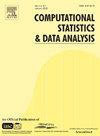测试高维分布的等式
IF 1.6
3区 数学
Q3 COMPUTER SCIENCE, INTERDISCIPLINARY APPLICATIONS
引用次数: 0
摘要
由于距离集中现象的存在,欧几里得距离不是一个适合高维环境的距离。提出了一种新的统计量,该统计量受点间距离的启发,但避免了点间距离的计算,用于比较和可视化高维数据集。新的统计是基于一个高维的不相似指数,利用了集中现象。同时显示观测均值和标准偏差,有助于可视化、可疑异常值的检测,并增强转换空间中竞争类之间的可分离性。研究了不相似度指标的有限样本收敛性,比较了几种分布下的9种统计量,并给出了3种应用。本文章由计算机程序翻译,如有差异,请以英文原文为准。
Testing the equality of high dimensional distributions
The Euclidean distance is not a suitable distance for high dimensional settings due to the distance concentration phenomenon. A novel statistic that is inspired by the interpoint distances, but avoids their computation, is proposed for comparing and visualizing high dimensional datasets. The new statistic is based on a high dimensional dissimilarity index that takes advantage of the concentration phenomenon. A simultaneous display of observations means and standard deviations that aids visualization, detection of suspect outliers, and enhances separability among the competing classes in the transformed space is discussed. The finite sample convergence of the dissimilarity indices is studied, nine statistics are compared under several distributions, and three applications are presented.
求助全文
通过发布文献求助,成功后即可免费获取论文全文。
去求助
来源期刊

Computational Statistics & Data Analysis
数学-计算机:跨学科应用
CiteScore
3.70
自引率
5.60%
发文量
167
审稿时长
60 days
期刊介绍:
Computational Statistics and Data Analysis (CSDA), an Official Publication of the network Computational and Methodological Statistics (CMStatistics) and of the International Association for Statistical Computing (IASC), is an international journal dedicated to the dissemination of methodological research and applications in the areas of computational statistics and data analysis. The journal consists of four refereed sections which are divided into the following subject areas:
I) Computational Statistics - Manuscripts dealing with: 1) the explicit impact of computers on statistical methodology (e.g., Bayesian computing, bioinformatics,computer graphics, computer intensive inferential methods, data exploration, data mining, expert systems, heuristics, knowledge based systems, machine learning, neural networks, numerical and optimization methods, parallel computing, statistical databases, statistical systems), and 2) the development, evaluation and validation of statistical software and algorithms. Software and algorithms can be submitted with manuscripts and will be stored together with the online article.
II) Statistical Methodology for Data Analysis - Manuscripts dealing with novel and original data analytical strategies and methodologies applied in biostatistics (design and analytic methods for clinical trials, epidemiological studies, statistical genetics, or genetic/environmental interactions), chemometrics, classification, data exploration, density estimation, design of experiments, environmetrics, education, image analysis, marketing, model free data exploration, pattern recognition, psychometrics, statistical physics, image processing, robust procedures.
[...]
III) Special Applications - [...]
IV) Annals of Statistical Data Science [...]
 求助内容:
求助内容: 应助结果提醒方式:
应助结果提醒方式:


